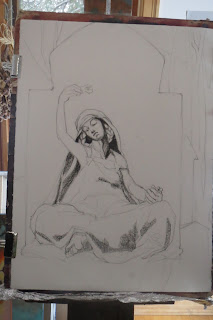While in Tuscany last year, I checked my Facebook one day, and saw that Ottawa artist Pina Rennick had posted a photo of this wonderful sculpture. She was on vacation in Paris. Co-incidentally, I was just ending my Tuscany trip and travelling shortly to Paris, to visit my friend Hana, whom many of you have seen in my paintings. I immediately e-mailed Pina to find out where she was (the flower seller), and got her location easily-Montmartre Cemetery, only a short walk from Hanas' apartment. How lucky!
Thank you Pina!!
This was the first week of November, and there were golden maple leaves everywhere. I sat down and did some sketches, and took many photos. Passerbys gave odd looks, as if it's weird to be sitting in a cemetery drawing these gorgeous mausoleums and sculptures. What?, I say.
When I first saw this sculpture I had an immediate hit to the heart, she touched me. Her forlorn-ness, her grace, and her beauty. She intrigued me, and I felt compelled to know more about her life. That's the thing about history though. Will we ever know as much we'd like? Mystery will remain, regardless of how much I find out.
I had to know more, and I knew instantly that this would turn into a painting for me.
Gustave Guillaumets' flower seller,
It didn't take much research time to find out all sorts of interesting information about this girl. The sculpture is the gravestone of artists Gustave Guillaumet, 1840-87. Noted: many charcoal sketches, in many public museums. In the last few years I have done many charcoal drawing/portraits, etc.
Guillaume attended the Ecole national superieure des beaux Arts - Paris, and in 1860, applied for a scholarship to study at the academy of France in Rome. but was turned down. Instead, Gustave travelled to Algeria to paint. He would return to southern Algeria 10 more times, fascinated with the desert people and their way of life. As soon as I heard Algeria, it immediately explained the clothing of the girl. At first I had though middle-eastern, but Algeria? OK.
The sculpture itself is credited to Louis Ernest Barrias, a contemporary of Gustaves, who studied at the same school. Where the story gets interesting, is upon Gustaves death, his wife commissioned Louis, to create a sculpture for Gustaves' tombstone using the study of a young girl from Bou Sadda, Algeria, (see Gustaves' sketch just above) as inspiration.
As a little gossipy aside, Gustave left his wife of many years, and his son, and moved in with his mistress who was many years his senior. A few weeks into living together, after an argument, Gustave shot himself in the lower regions, but didn't kill himself! He contacted his wife, and he returned home, dying some weeks later of complications to do with his wound. Still, his wife honoured him with this tombstone - an elegant beautiful sculpture created by a contemporary colleague of Gustaves', inspired by the sketch of the flower seller.
Gustave was an artist, who was inspired by the young girl of Bou Sadda. She experienced her first renaissance from Louis, who raised her arms, and threw flowers on Gustaves' grave. Then I found inspiration from Louis' interpretation, and she lives once more, in her second renaissance, as per the title of my painting. The title is french, in honour of where the gravestone exists, in the Montmartre Cemetery, Paris, France.
PROCESS
And now for a little on the process used to create my painting.
First of all, I started with a full sheet of WC paper, and drew out the flower seller in charcoal. I couldn't wait to get to her tilted head and face. The gravestone itself, I wanted a little off centre, so as to not have a symmetrical composition. There was much detail in the background, which I would simplify to just a few trees.
The line drawing, decisions on relationship of gravestone to sculpture to negative space. Love drawing hands and face.
Starting to add in value, charcoal and black pastel.
On the way to a full traditional monochromatic study.
Without the complete detail, but enough of a block in of the light, medium and darks. I am ready to underpaint/overpaint. First, I use Lascaux permanent fixative, and let dry.
Before I underpainted, a lot of imagination and thought went into what will remain in pastel, on top of the underpainting. What kind of an effect am I trying to achieve and how can the right underpainting help build depth and the desired contrast, that will enhance the effect I am trying to achieve? These are my thoughts on all underpainted surfaces.
In this particular case, I knew I wanted a warm underpinned colour in the sky area, as the predominant finished surface would be quite cool.
And now, I start with pastel. I found yellow maple leaves were everywhere, and the colour was a great hit of pure hue contrast with the mostly very cool and lower key palette. Also, as the painting is titled "renaissance", I decided the flowers in her hands should have some colour, adding to the harmony of the pallette, and bringing her flowers, somewhat back to life.
As I move through the layering of the pastel, the colours and values are adjusted in smaller and smaller increments.
In finding my voice as an artist, every once in a while, you have a moment. As it was with this piece, where the grace and elegance of this young girl encapsulates the feeling of what I would like to bring to my viewers. Peace and beauty. Elegance, my deep love for drawing, with an understated sense of colour.
Thank you for listening.








